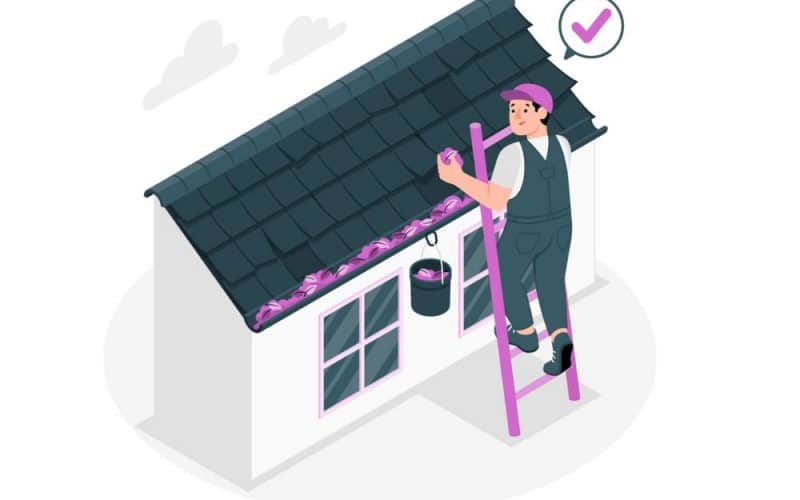Does home insurance cover roof replacement? Yes, a typical all-perils homeowners insurance policy does cover the replacement of your roof and the cost of replacing it if it gets damaged. However, that’s the good news.
The bad news is that you’re covered only if the damage or destruction results from a sudden accident or act of nature. Problems that ensue from general wear and tear or from a roof that has exceeded its intended life span are not eligible for reimbursement. This is because they fall under the general maintenance responsibility of the homeowner.
Also, insurance-funded roof replacement is typically limited or excluded from your home insurance policy when roofs are 20 years or older. If you have an older roof, your insurance company may also require a roof inspection before insuring your home. They may also only allow for actual cash value in case of damage.
How roof coverage insurance works
Repairing or replacing a roof can be costly. While they are built to withstand the elements, including sun, wind, freezing temperatures, hail, rain, and more, a roof — no matter how well it is built — weakens over time, making it more vulnerable to damage.
Of all the parts of your home, the roof arguably has the most direct exposure to the elements. For northern climates, there is the weight of heavy snow and hail or ice storms. In the Midwest, tornados and cyclones are also common problems. In tropical climates, there is the potential for gales and hurricane-force winds.
Not only can Mother Nature do direct damage, but she can also trigger other sorts of havoc —like a violent windstorm that topples a tree onto your roof. There may be wildfires. Or there could be more unlikely incidents, like debris from an explosion or aircraft crashing down on the roof from above.
Happily, the roof is an integral part of the structure of your home, and so the dwelling coverage section of your homeowners’ insurance policy typically protects you from such perils. Damage and destruction from such events qualify the homeowner for a total or partial replacement of the roof.
An insurance company could deny coverage if the roof is older or not well-maintained. Instead, the carrier may decide to provide actual cash value insurance, which only pays for a portion of a claim based on the roof’s age and condition. The Texas Department of Insurance explains how the actual cash value for a roof that will cost $10,000 to replace could work:
| 5-year-old roof | 10-year-old roof | 20-year-old roof | |
|---|---|---|---|
| Actual cash value of roof | $8,500 | $7,000 | $4,000 |
| Minus deductible | – $4,000 | – $4,000 | – $4,000 |
| Policy would pay | $4,500 | $3,000 | $0 |
Types of roof damage
There are two main types of roof damage when it comes to home insurance:
- damage from a covered loss
- wear and tear
For example, if your roof has a leak or damage due to covered perils such as rain, hail, snowstorm, a falling tree branch, wind, or fire, the insurance company will usually step in to pay for the repair or replacement up to your coverage limits. This is assuming your policy has no exclusions regarding your roof.
If there is a leak that is not associated with a covered peril due to something such as the failure of the structure, lack of maintenance, or the roof’s older age, an insurance company will likely not cover the cost to repair the damage or replace the roof. Ongoing roof maintenance and upkeep is crucial to not only maintaining your roof but also to taking advantage of the financial protection offered by your homeowners’ insurance.
If you are unsure what your home insurance policy covers and does not cover, talk with your insurance agent so you aren’t caught unprepared.
What kind of roof damage is covered by insurance?
Many insurance companies list the causes of damage they’ll protect against in your policy documents, like fire and wind. Sometimes, your insurance company might list the causes that aren’t included instead.
Types of roof damage usually covered by insurance
- Wind and hail
- Lightning
- Fire and smoke
- Weight of snow or ice
- Falling objects
- Vandalism
Types of roof damage not covered by insurance
- Normal aging
- Gradual wear and tear
- Neglect
- Earthquakes and flooding
- Rot or mold
- Animals
Some home insurance companies will exclude wind and hail damage from your policy if you live in a place where hurricanes or tornadoes are common. If natural disasters are common where you live, you should talk to an insurance agent to make sure you’re fully protected.
Special considerations for roof coverage
If a dramatic event causes dramatic damage — the roof comes crashing down, has a major hole, or is torn off entirely — coverage is likely.
More problematic are instances when the damage is less dramatic, even if an act of nature caused it. Let’s say a violent thunderstorm nicks a bunch of your roof’s shingles. The insurance company may classify that as cosmetic damage, and not cover it. Or let’s say that, after the aforementioned storm, you notice your roof has become leaky. Even though the rains triggered it, the insurance company might claim that’s a general wear-and-tear problem — reflecting your roof’s gradual deterioration — which is never covered.
Ironically, any water damage caused by the leaking roof to your walls, floors, or furniture probably would be covered under the all-perils section of your policy. However, the roof repair itself would not be.
Do I have to pay a deductible for roof replacement?
Yes, you will have to pay a deductible before your home insurance company will repair or replace your roof.
Most of the time, your roof deductible will be the same as the overall deductible that you chose when you bought your policy.
Sometimes insurance companies will set a different deductible if your roof is damaged by weather events like wind, hail, hurricanes, and windstorms. This is common for homes located on the coast or in an area with frequent storms. In this case, the deductible is usually a percentage of your dwelling coverage limit.
How to get insurance to pay for roof replacement
After your roof is damaged, there are five main steps you should follow for a smooth roof replacement process.
Step 1: Make temporary repairs and get an estimate
The first thing you should do after discovering roof damage is to hire a professional to make temporary repairs. This will lessen the amount of further damage to your home, often called secondary damage, which can save you a lot of money on repairs.
If your home insurance claim is approved, your insurance company will include the cost of any temporary repairs in your overall settlement. Before you make temporary repairs, ask the roofing company to have someone take pictures of your roof and any damage they find.
You should have the company put together an estimate to repair or replace the roof, too. You’ll want to send the photos and estimate to your insurance company if you decide to file a claim.
Step 2: Review your insurance policy
Before you file a roof insurance claim, review your policy to make sure that the damage is covered and get an idea of how much your settlement could be.
You don’t want to submit a claim if you know it won’t be approved, because even a denied claim will show up on your claims history.
It usually won’t affect your home insurance rates on its own since there was no payout. But if you file a number of claims within a short period of time, the insurance company may see you as a higher risk and increase your rates.
It’s also important to have an idea of how much money you might get from the insurance company. If you’re only making some small repairs or you have a high deductible, the amount you’ll receive might not be worth the potential increase in your insurance rates.
Step 3: File a roof insurance claim
Most major insurance companies give you the option of filing a homeowners insurance claim for roof damage through your agent, over the phone, online or via their mobile app. You should be prepared to provide your insurance company with several key pieces of information.
- The date and cause of the roof damage
- The age and building material of your roof
- A list of any secondary damage
- Photos or videos of the damage
- The bill for any temporary repairs you made
- An estimate to repair or replace the roof
If you have made any repairs to your roof before the damage or have a recent roof inspection report, it can be helpful to provide these documents as well.
Step 4: Meet with the insurance adjuster
After you’ve filed a roof replacement claim, your insurance company will assign an adjuster to your case. The adjuster will schedule a time to come out to your home to inspect your roof and any other damage that occurred.
It’s the adjuster’s job to help determine whether the insurance company is responsible for the cost of your new roof, so be prepared with anything you have that can help them understand how the damage happened and how much it will cost to fix.
Step 5: Get the settlement and fix your roof
Once your claim has been approved by the insurance company, it will decide how much it will cost to replace your roof and send you a settlement check.
Oftentimes your insurance company will send you a partial check to help you hire a contractor and get the work started. This is because your roof is an important part of protecting the rest of your home and your insurance company wants to make sure it’s done to its standards. You’ll generally receive the final payment after the roof work is done and the adjuster inspects the new roof.
Tips to save on new roof costs
The average price range for a roof replacement can run from $1.50 to $4.50+ per square foot depending on the roofing material used. Sometimes, roofing estimates will quote by the “square,” which is used to describe a 10’x10′ area, or 100 square feet (so you may see a quote for something like $325 per square).
Here are some tips on how to minimize your repair and replacement costs:
- Do your research: Know the size and complexity of your roof and the exact materials you want to have installed before talking to contractors.
- Shop around: Get quotes from several roofers and always request and check local references before hiring someone. Be wary of extremely low bids, which could mean subpar work, and make sure roofers offer a warranty on materials and installation.
- Time it right: Roofers are busiest in late summer and fall. Scheduling your roof replacement in late winter or spring may yield lower prices or off-season discounts.
- Do it (or some of it) yourself: Consider doing part of the work yourself. If you have the time, the proper equipment, and a stomach for heights, removing old roofing before the installer arrives could help cut costs.
- Consider an overlay: An overlay involves installing new shingles on top of existing ones. Because the old roofing stays put, overlays require fewer hours of labor and cost less than a full replacement. However, an overlay may void or shorten the manufacturer’s warranty on roofing materials. Overlays also typically increase future replacement costs due to increased labor and job waste.
How to keep your roof safe
Roofs are expected to hold up to weather conditions, but a well-maintained roof is typically more resilient against the elements than an aging roof that has suffered from wear and tear over the years. While you may not want to replace your whole roof regularly, ongoing maintenance could protect your roof and make sure it holds up better over time:
- Schedule a periodic inspection: If you’re unsure if your roof is holding up, or if you notice a leak or other indication that your roof may be suffering from damage, hire a roof inspector to take a look and determine if there are any structural issues. You can schedule an inspection every couple of years and address minor problems before they become significant ones.
- Prune nearby trees: One of the most common causes of damage to roofs are trees. Falling branches and other debris can impact the roof and cause damage during a storm or heavy winds. Cutting back and pruning nearby tree branches could help minimize this type of damage.
- Keep gutters clean: Gutters are meant to carry water — what could be a roof’s biggest enemy — away from the rooftop. If your gutter is filled with leaves or debris, water could overflow onto the rooftop, weakening the structure or causing interior leaks.
Roof repair vs. roof replacement
When deciding on whether to repair or replace your roof, you might want to consider the following options:
| Repair… | Replace… |
|---|---|
| If the damage is minor and localized | If the damage is widespread |
| If the roof is 10 years old or less | If the roof is older or you plan on selling your home in the near future |
| If non-matching new shingles do not affect the home’s curb appeal | If the cost of repair is close to the cost of a full replacement |
Recommended Articles
- How Much Dwelling Insurance Coverage Do I Need?
- HOW MUCH IS FLOOD INSURANCE: 2023 Price Guide
- WHAT IS DWELLING COVERAGE? All You Need To Know
- What Is Hazard Insurance for Homeowners? 2023 Guide
- Hazard Insurance vs. Homeowners Insurance: How Do They Differ?
- Renters Insurance Wisconsin: Coverage, Cost & Finest Options





